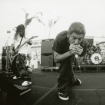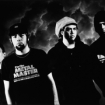Loud music asserts itself in strange ways into the life of Chino Moreno. At the moment, the Deftones singer is back at his current home base of Bend, Oregon, standing in a basement bar owned by a friend and trying his luck on a Kiss pinball machine. It pings and stirs with action, blasting the vintage rock tunes "Deuce" and "Lick It Up," until the steel ball lands down the gutter and Moreno finally surrenders to the God of Thunder: "You got me again, Gene."
Hours earlier, he continued his daily routine of deep diving into the catalog of a particular artist or band, studying the highs and lows, what worked and what didn't. Today it was Kiss, tomorrow someone else, fueling Moreno's endless obsession to understand the art and mechanics of sound. For his own Deftones, that mystery may be a continuously unraveling puzzle, but Moreno knows exactly when its major turning point came: in 1997 with the making of their second album, Around the Fur.
"That's my favorite record," he says without hesitation, now sitting, a beer in front of him, in a buttoned-up Pendleton and purple trucker's cap. "We were very confident — knowing that what each one of us had to offer, individually and collectively, as a band couldn't be fucked with."
Around the Fur is where they figured it out, where the Deftones sound came fully into focus with churning riffs and vocals that were agonized and contemplative, angry and soaring. It created a yearning yet aggressive musical landscape that sounded like no one else, setting the Deftones name apart from that decade's tsunami of sound-alike nu-metal bands. Produced by Terry Date, the album was completed in Seattle in just four months — writing, recording, mixing. (The follow-up, 2000's White Pony, would take much longer to complete.) The band's expanded musical and emotional range could be heard in the first moments of the opening track, "My Own Summer (Shove It)," with Stephen Carpenter's calmly aggro riffs bouncing to precision beats from Abe Cunningham and Chi Cheng's ripping bass lines; Moreno's dreamy vocals erupting with rage that the singer now says was very real.
"I was probably angrier than I've ever been in my life, but I was probably happier than I ever was in my life," Moreno recalls. "Every emotion was like the pinnacle of all those emotions. Some of the saddest parts of that record are really sad. Some of the angry parts of that record — I don't know if I can ever be that angry again ... There's good in that. I'm kind of happy because I don't want to be that person anymore. It's a time capsule. Fuck, I was mad! And scathing, in some of the things I was saying, but I meant it."
In the 20 years since they released Around the Fur, the record has sold more than a million copies, and the Deftones now occupy a top spot in the pantheon of successful heavy music acts. But back in the Nineties, they were still a young, mostly unknown band from Sacramento, California, spending their days and nights at The Spot, the group's clubhouse and studio space. There was a custom skate ramp inside. The place was surrounded by businesses, so any loud Deftones work had to wait until 6 p.m. every day. Carpenter spent his downtime on a BMX bike on the ramp, Moreno and the others on boards. Friends and local skate and BMX pros would join them.
"Skateboarding to me was probably equally as important as music," Moreno says. "We still were young. We already felt very successful for the fact that our job was to make music and go on tour. We didn't really make that much money back then, but I don't think we really needed much money. We lived very simple lives ... At that point, we were skirting that line of kind of being responsible, but really living life to the fullest. As soon as 6:00 would come, we started making noise."
As the band began preliminary work on what would become Around the Fur, the founding Deftones quartet was down to three as Cheng contemplated leaving the band for a straight life as an English teacher. (Keyboardist/DJ Frank Delgado was entering the picture but not yet as a full-time member). Cheng moved south from Sacramento to San Diego with his wife and baby and made plans to finish school. Moreno, Carpenter and Cunningham began writing at The Spot without him. "We actually wrote a lot of the record without bass. It was just guitar, vocals and drums," says Moreno. "We spent every day at the studio." Cheng returned in time for the sessions in Seattle.
Back in charge was Date, who also produced the band's 1995 debut, Adrenaline. He'd been picked by the band based on the four albums he produced for Pantera, including the band's 1992 career-defining Vulgar Display of Power. "At that point, those were some of the heaviest, piercing, great records," says Moreno. But the results on the Deftones' first effort with Date were hugely disappointing to Moreno. Blame for that goes not to the producer but the band, he says. "We tied his hands behind his back because we told him, 'We love you because of this, but we don't want it to sound like Pantera,'" he says of making Adrenaline. "We just wanted to record it raw."
For Around the Fur, the band allowed Date to bring all his skills to bear. The goal was a big, sophisticated recording that retained the urgency and hard edges of live Deftones. Moreno compares that mission to the leap in production values that Metallica made with their 1991 self-titled LP (a.k.a. "The Black Album").
"[Metallica] were tired of their records sounding shitty — they wanted to sound big, but not over-polished," he says. "With Around the Fur, we came to that epiphany where, 'OK, we don't want it to sound like a garage fucking record. We want it to sound big, but we don't want it to sound corny.' What we accomplished on that record — the drum sounds, the vocals we produced — it was warm, but it was heavy, and it was something new. It was something original."
If future albums were fueled by sometimes painful brotherly conflict within the group, Around the Fur emerged when band members were at their closest. Building on what they had begun writing in Sacramento, the Deftones players wrote more songs in the studio in Seattle, including the key tracks "My Own Summer (Shove It)," the riff-heavy "Lhabia" and the album's title song, with its ominous scraping of strings and horror-show atmospherics between raging verses.
"I'm just sitting around smoking bong hits, and Terry's going, 'Get out there and write a song!'" remembers Carpenter with a laugh. "And I'm like, 'Alright, let me smoke another bowl. I've got to get it right."
It was the band's second time recording in Seattle, this time at Studio Litho, owned by guitarist Stone Gossard of Pearl Jam. "We felt like family with Terry," Carpenter says of Date, who ended up producing the band's crucial first four albums. "He wasn't telling us what to do. Now in hindsight, maybe he should have told us something, but what you hear on every one of those records was him letting us be ourselves."
With whispers and screams, Moreno found his true voice at the sessions, allowing his Morrissey and Depeche Mode obsessions to show between the thundercracks. Carpenter, too, was under the smoky electronic Depeche spell, and remembers playing that band's then-new Ultra album on permanent repeat at the time. The track "Be Quiet and Drive (Far Away)" fully captured the classic Deftones sound that would flourish on White Pony, colliding extremes of beauty and noise, with beats and riffs to mirror the emotional ups and downs of the vocals.
They spent six hours a day in the studio. Regular visitors included grunge locals Alice in Chains and the SoCal punk band Unwritten Law, who were also in town recording. Max Cavalera of Sepultura and Soulfly came in to shout and collaborate on the frantic tune "Headup." The Deftones dudes would then crank up rough mixes of the day's work on cassette tapes in the car, explore the scene in Seattle and then retreat to the swimming pool of their apartment complex.
"It's crazy because I don't remember so much of being in the studio recording as I do all the other stuff we did, like, all the extracurricular activities," Moreno recalls. "We stayed out and went swimming every night, having parties in the hot tub."
At one of the parties, photographer Rick Kosick shot a fisheye picture of a girl in a bikini, a flower tattooed around her navel. The band saw the extreme close-up, with Kosick's lens leering over her breasts, and chose it for the cover of Around the Fur. On the label side of things at Maverick/Warner Bros., the sudden, lucrative rise of nu-metal was noticed as it drew big crowds and multi-platinum sales. Deftones were already seen as a promising new force in that movement, even if the group had other ideas.
"Papa Roach and Limp Bizkit and stuff like that were becoming really big bands, and bigger than us,"Moreno remembers. "The label would sort of hint, 'Well, this music right now is selling really big so you guys should capitalize on this,' and we were totally anti that. Not that we thought we were better than all these bands. It wasn't like that. We just wanted to do something a little more left of center."
With Around the Fur, the intense quartet from Sacramento went their own way, leaving behind the nu-metal clichés. On "Mascara," Carpenter stepped away from straight-ahead riffage for something more dissonant and weird. At the same time, Moreno was becoming one of the most distinctive vocalists in heavy music. If the results seemed avant-garde, it's just what emerged naturally during their months in Seattle.
"We just had a lot of confidence at that point," says Moreno. "That confidence spawned us toward making the exact record that we wanted to make at that exact moment in time. There was no second-guessing ourselves. We were just really having fun as a band and as friends. We were all living together in an apartment in Seattle — spending every minute of the day together just making music."
Once the record was done, they hit road together, and the Deftones were never more intense than those years in the late Nineties. Onstage, the music and the moment would overtake all of them, as Moreno nearly slipped into a trancelike state, climbing barricades and speaker stacks, diving or tumbling into the crowd. He lost a pair of sneakers every night. "In my mind, we were one of the best live bands in the world," he says. "I didn't constantly say, 'Well, I'm gonna see how crazy I can be,' but I was just really free and I didn't care about tomorrow and just enjoyed every essence of every moment."

The crowds were just as intense as the action onstage. At one 1998 show in Belfast, Northern Ireland, the singer dove into the crowd and soon had an ecstatic young dude arm-choking him tight around the neck. "I kind of knew that he wasn't trying to hurt me, but I straight-up was getting my air cut off, and all the other guys in the band saw it and were like, 'What the hell's going on?' My man was choking me out! I've seen that picture and the dude is straight choking me out of just pure happiness."
The road otherwise continued the wild times and creative excitements they knew in Seattle. Typically, backstage, Moreno says now, "was like rock & roll debauchery at its peak." That same year, Deftones were back on the Warped Tour, hitting every city by bus, partying and raging all night long.
"We wouldn't go to bed until the sun was up," Moreno goes on. "Sometimes I'd wake up and would really be wiping my eyes and they're like, 'Dude, you gotta go onstage.' I'd crack a beer or two and guzzle them and then just go onstage and play."
In August 2017, we visited Chino Moreno in Bend, Oregon, where he lives, and talked to him about his deep relationship with music and how it relates to the Deftones' creative process. Below, watch Moreno talk about how inter-band conflict fuels and challenges the group creatively.














